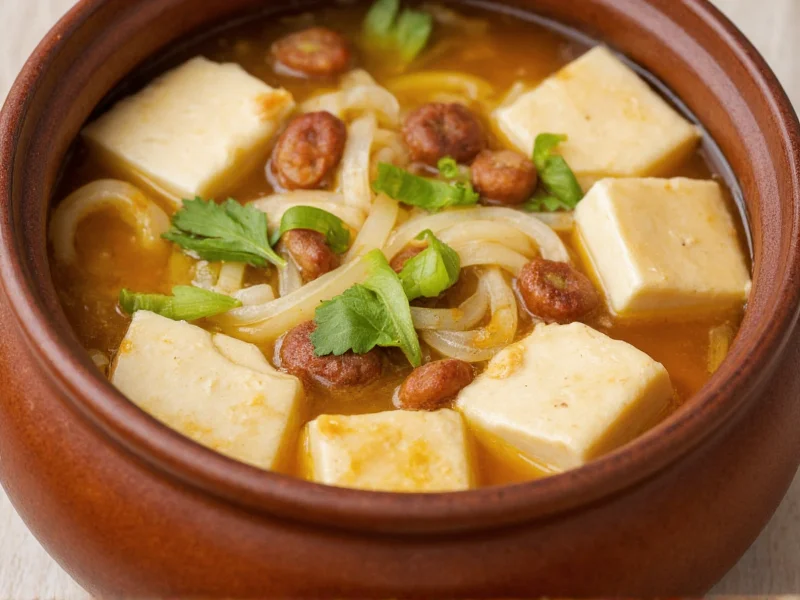Understanding Tofu Varieties for Soup Applications
Not all tofu performs equally in soup. The protein coagulation and water content determine how well tofu holds up in liquid environments. Understanding these differences helps prevent disappointing results like crumbly or waterlogged tofu in your broth.
| Tofu Type | Water Content | Best Soup Applications | Texture in Soup |
|---|---|---|---|
| Extra-Firm | 80-85% | Hearty broths, ramen, vegetable soups | Holds shape well, maintains bite |
| Firm | 85-87% | Miso soup, Asian broths, stews | Slightly softer but maintains integrity |
| Soft | 88-90% | Creamy soups, blended applications | Begins to break down, adds body |
| Silken | 90-93% | Miso soup, cold soups, creamy bases | Dissolves easily, creates smooth texture |
Proper Tofu Preparation Techniques for Soup
Simply dropping tofu into soup leads to disappointing results. Proper preparation transforms tofu from a bland protein into a flavor-absorbing component that enhances your soup.
Pressing tofu remains the most critical step for firm varieties. Place the tofu block between paper towels or a clean kitchen cloth, then apply weight (a heavy skillet works well) for 15-30 minutes. This removes excess water that would otherwise dilute your broth and prevents the tofu from absorbing too much liquid and becoming waterlogged.
For enhanced flavor absorption, try marinating pressed tofu in soy sauce, rice vinegar, or dashi for 15-30 minutes before adding to soup. Some chefs recommend freezing tofu before use—this creates a more porous texture that readily absorbs broth flavors while maintaining structural integrity during cooking.
Timing Matters: When to Add Tofu to Soup
Adding tofu at the wrong stage ruins texture. For firm and extra-firm varieties, introduce tofu during the last 5-10 minutes of cooking. Boiling temperatures cause tofu to break apart, while gentle simmering preserves its structure.
Silken tofu requires even more careful timing—add it after removing soup from heat to prevent complete disintegration. The residual heat warms the tofu without destroying its delicate texture. For miso soup specifically, dissolve miso paste in a small amount of broth first, then add silken tofu before incorporating the miso mixture back into the main pot.
Avoiding Common Tofu-in-Soup Mistakes
Cooking with tofu in soup presents specific challenges that frustrate many home chefs. Understanding these pitfalls leads to consistently better results:
- Adding unpressed tofu—excess water dilutes broth and creates soggy tofu
- Boiling tofu too long—causes crumbling and texture loss
- Using the wrong tofu type—silken in hearty soups or extra-firm in delicate broths
- Adding tofu too early—prevents proper flavor absorption
- Cutting tofu too small—increases surface area, leading to faster breakdown
For heartier soups requiring longer cooking times, consider baking or pan-frying tofu cubes first. This creates a protective exterior that withstands extended simmering while maintaining interior tenderness.
Nutritional Benefits of Tofu in Soup
Incorporating tofu into soup delivers significant nutritional advantages beyond just protein content. A 3-ounce serving of firm tofu provides approximately 7-10 grams of complete protein containing all nine essential amino acids. Unlike meat-based proteins, tofu contains zero cholesterol and minimal saturated fat.
Tofu serves as an excellent source of calcium (when prepared with calcium sulfate), magnesium, and iron. The isoflavones in soy may offer cardiovascular benefits when consumed regularly as part of a balanced diet. When added to vegetable-rich soups, tofu creates a nutritionally complete meal with balanced macronutrients.
Popular Tofu Soup Variations Worth Trying
While basic tofu soup remains popular, creative variations showcase tofu's versatility. Korean sundubu-jjigae features soft tofu in a spicy broth with vegetables and seafood. Japanese hiyayakko transforms silken tofu into a cold soup perfect for summer.
For Western palates, try adding cubed firm tofu to minestrone during the final minutes of cooking. In creamy soups, blend silken tofu with roasted vegetables for a dairy-free alternative that adds protein without altering flavor significantly. The key to successful tofu integration remains respecting the specific requirements of each tofu variety.
Final Recommendations for Perfect Tofu in Soup
Mastering tofu in soup requires understanding the relationship between tofu type, preparation method, and cooking technique. Always match the tofu variety to your soup's cooking method and desired texture outcome. Press firm varieties thoroughly, time your additions carefully, and consider flavor-enhancing techniques like marinating or freezing.
When executed properly, tofu transforms from a simple protein addition into an integral component that enhances both texture and nutrition of your soup. The best tofu-in-soup experiences come from respecting tofu's unique properties rather than treating it as a direct substitute for other ingredients.
Frequently Asked Questions
Can I use silken tofu in regular soup recipes?
Silken tofu works best in delicate broths like miso soup or cold soups. In regular boiling soups, silken tofu will break down completely. For heartier soups, use firm or extra-firm tofu instead, which maintains its structure during cooking.
How do I prevent tofu from falling apart in soup?
Press tofu thoroughly to remove excess water, cut into larger cubes, and add during the last 5-10 minutes of cooking. For longer simmering soups, consider pan-frying or baking tofu first to create a protective exterior that prevents crumbling.
Does tofu absorb soup flavors effectively?
Yes, properly prepared tofu readily absorbs surrounding flavors. Pressing removes excess water that would otherwise block flavor absorption. Marinating pressed tofu in soy sauce or dashi before adding to soup significantly enhances flavor integration. Freezing tofu creates a more porous texture that absorbs broth even better.
What's the nutritional difference between tofu types in soup?
Extra-firm tofu contains slightly more protein per ounce (about 10g per 3oz) compared to silken (about 7g per 3oz) due to lower water content. Both provide complete protein with all essential amino acids. Calcium content varies based on coagulant used—calcium sulfate-prepared tofu offers significant calcium, while nigari-prepared contains more magnesium.











 浙公网安备
33010002000092号
浙公网安备
33010002000092号 浙B2-20120091-4
浙B2-20120091-4